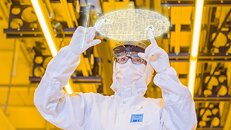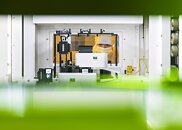Wednesday, June 9th 2021
Bosch Unveils One Billion Euro Chip Manufacturing Facility in Germany
Robert Bosch GmbH, commonly known as just Bosch, has today unveiled the results of the company's biggest investment ever. On Monday, the company has unveiled its one billion Euro manufacturing facility, which roughly translates to 1.2 billion US Dollars. The manufacturing plant is located in Dresden, Germany, and it aims to supply the leading self-driving automobile companies with chips that are in great demand. As the main goal for the plant is to manufacture chips for the automotive industry, this new 7,200 m² Dresden facility is supposed to provide car makers with Application-Specific Integrated Circuits (ASICs) for power management and tasks such as triggering the automatic braking system of cars.
The one billion Euro facility was funded partly by the funds coming from the European Union investment scheme, which donated as much as 200 million Euros ($243 million). The goal of the plan is to start with the manufacturing of chips for power tools as early as July and start production of automotive chips in September. All of the chips will be manufactured on 300 mm wafers, which offers a major improvement in quantity compared to 200 and 150 mm wafers currently used by Bosch. The opening of this facility will surely help with the global chip shortages, which have even hit the automotive sector.
Sources:
Bosch, Forum member P4-630 (Many thanks for the tip!)
The one billion Euro facility was funded partly by the funds coming from the European Union investment scheme, which donated as much as 200 million Euros ($243 million). The goal of the plan is to start with the manufacturing of chips for power tools as early as July and start production of automotive chips in September. All of the chips will be manufactured on 300 mm wafers, which offers a major improvement in quantity compared to 200 and 150 mm wafers currently used by Bosch. The opening of this facility will surely help with the global chip shortages, which have even hit the automotive sector.




19 Comments on Bosch Unveils One Billion Euro Chip Manufacturing Facility in Germany
I guess this will no smaller than 12nm, as most automotive parts aren't on cutting edge nodes.
Seems to be nothing smaller than 65nm, which is a lot bigger than I expected.
www.eenewsanalog.com/news/boschs-dresden-wafer-fab-prepares-production
Not sure about car brains and autonomous taxis, but we are sure gonna get a shitton of new EVs.
Now on top of this car brains dont have giant heatsinks and 120mm fans. They are typically ultrabook power level with passive cooling. Sub 10 watt 65nm CPUs are not powerful enough to handle the workload of modern cars.
Thats an awful lot to manage with a 65nm ARM chip from 12 years ago.
And few board's have one piece of silicon on shit look in your Pc, how many chip's are the Main CPU in there.
Not that your wrong about AI, maybe it's scale of use but that shits marginal still ,anyway, power delivery and control hardware alone accounts for plenty of dies.
Try fixing some cars the amount of parts now With chips in there for some thing or other is beyond belief, I get oily often.
Your 7nm AI audio center talks through canbus the same as your door lock, key, window motors, I could go on, via protocols.
The heavy lifting is spread out, and the diagnostic and control systems, on canbus, are expensive.
Your hyperfocusing on use cases othe foundries will supply for, this will still, lighten the load but not a smidge of difference will come of it on the GPU shelves.
Again, not convinced.We aren't talking 12 years ago. There are 65nm arm chips still being made now, today.I specifically excluded self driving car functions. I'm talking for a baseline automobile.
No it won't be a dream car. It will work however.is generally 720p on most car displays I have seen? We aren't talking luxury cars.
The LG G3 was 65nm and ran a 1440p display for comparison sake.